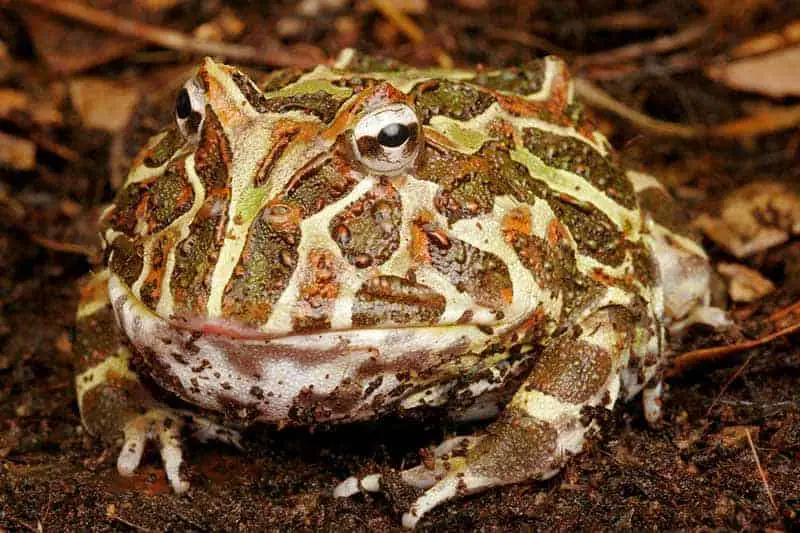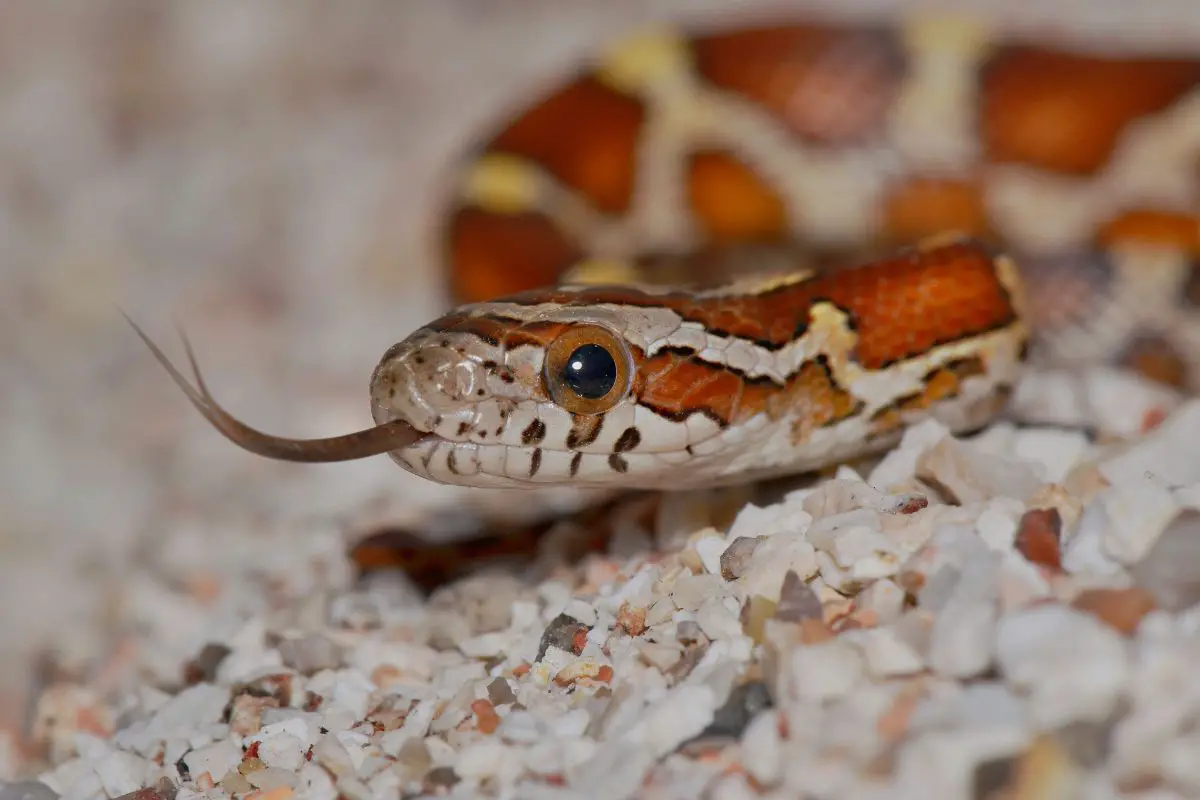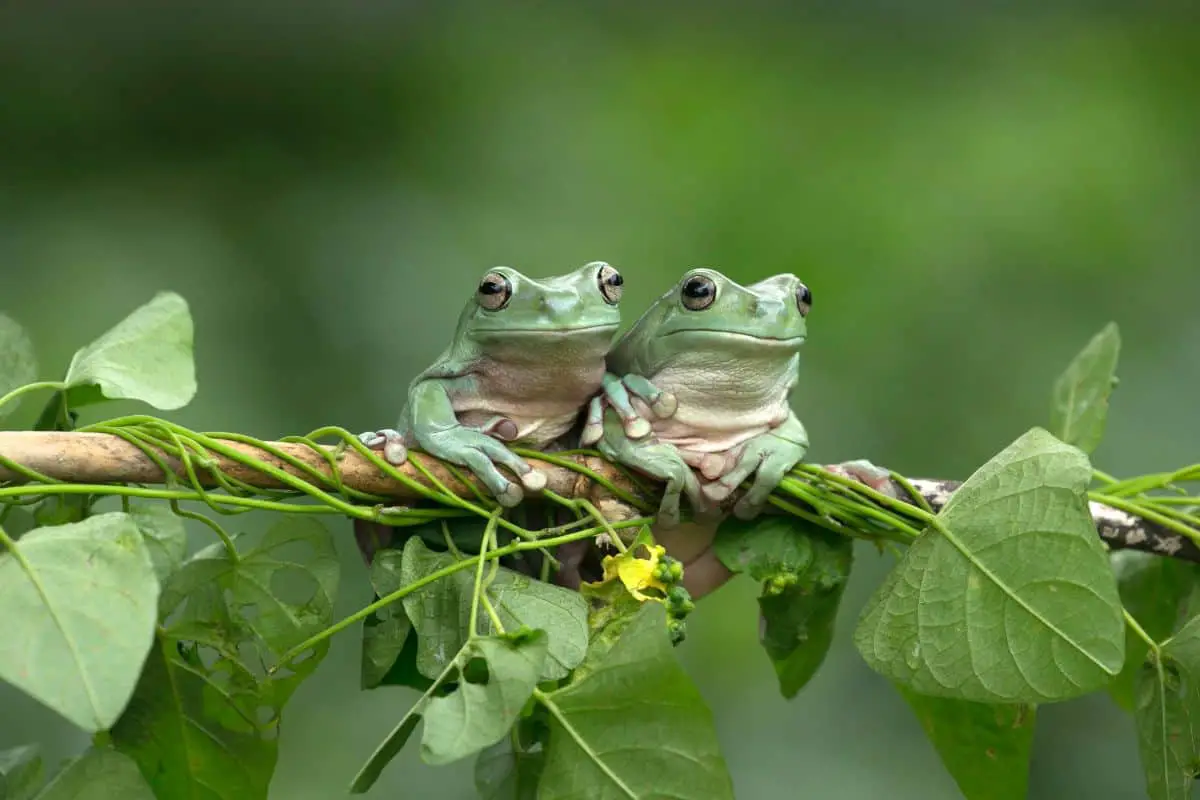Pacman frogs are one of the most popular pet frogs in the world. They’ve been bred into several beautiful color morphs, and their bizarre body shape makes them somewhat more interesting than many other frogs.
They’re also a low-maintenance, easy to care for species that are well suited to beginners, and interesting enough that even longtime exotic pet keepers love them. Here’s everything you need to know about caring for a pacman frog.
Pacman Frog care sheet
Common name: South American Horned Frog, Pacman frog
Scientific name: Ceratophrys cranwelli, Ceratophrys cornuta, Ceratophrys ornata
Range: Argentina, Brazil, Bolivia, Suriname, Colombia, Venezuela
Lifespan: 5-7 years
Adult size: 4-8 inches long
Temperament: Somewhat aggressive. May bite if handled.
1. Housing
Pacman frogs are fairly large frogs, but they’re sedentary. They spend much of their time half-buried in the substrate- in the wild, this is how they ambush their prey. Plus, their bodies, with disproportionately big heads and smell legs, just aren’t built for lots of activity.
That doesn’t mean they can handle tiny spaces, though. They still like to move, and have multiple areas they can hide. They also like to soak in their water bowls. When it comes to the care for pacman frogs, the rule of thumb is to house them in a minimum of a 10-gallon tank. You can opt for a 20-gallon tank, but anything beyond that is probably excessive.
The tank needs from for a hide, open space, a water dish, and some vegetation (this can be live plants or fake ones). The water dish should be shallow enough that your frog can soak in it without drowning- pacman frogs don’t swim and they’re not aquatic. They just like to sit in the water from time to time to cool off and keep their skin moist.
Recommendations
Terrarium– The Exo Terra Short All Glass Terrarium has plenty of space for an adult pacman frog, and it’s very well-designed. The front-opening doors make feeding and cleaning simple, and the raised bottom frame is perfect for adding a substrate heater.
Hide– Your pacman frog will spend a lot of time burrowed into the substrate, but it will still like having a nice hiding spot like this rock hideout. This helps them feel safe and secure.
Vegetation– You can use fake plants if you need to but live plants like this pothos ivy help to keep the air inside the terrarium fresh and will process feces, keeping it cleaner, too. They also provide additional hiding spots for your frog.
Check out this article for more enclosure options for pacman frogs.
2. Temperature and lighting
Pacman frogs do best in temperatures of 75-85 degrees. Remember that frogs can’t regulate their own body heat, so you actually don’t want the whole terrarium at the same temperature. There should be a temperature gradient, with one side of the terrarium warmer and the other cooler.
Since amphibians don’t bask in the sun the way reptiles do, you won’t need a basking lamp. Instead, you’ll want a substrate heater under one side of the tank. Usually, the substrate heater is placed underneath the hide on one side, while the water dish is placed on the other side. This way they’re able to warm up while staying hidden if they want, and the water dish becomes a very effective means of cooling off when they need to.
Since pacman frogs in the wild live on the forest floor, they don’t actually need much in the way of special lighting. All they really need is enough lighting to provide a typical day/night cycle. Regular compact fluorescent bulbs work just fine.
Recommendations
Heater– This small substrate heater works great. It will keep one side of the tank warm without overheating the other side.
3. Diet and feeding
These frogs are voracious eaters, and they’ll eat almost anything that they can fit in their mouth. Generally, their diet should consist mostly of insects. Crickets are usually the easiest to find, although you can usually find plenty of roaches as well. They’ll love either one, although most people prefer to use crickets, if only because they’re creeped out by the roaches!
Make sure you’re feeding your frog gut-loaded insects. That means that the bugs have had their own full meal before you feed them to the frog. This provides added nutrition to the frogs diet. You’ll also want to dust your crickets or roaches with a calcium supplement to make sure their getting enough of the mineral.
Many people like to feed mice to their pacman frogs. This is fine, and your frog will enjoy the treat, but there’s no need to make mice a dietary staple for the frog, and if you feed them live mice, don’t leave them unattended. A mouse can cause fatal injuries to your frog.
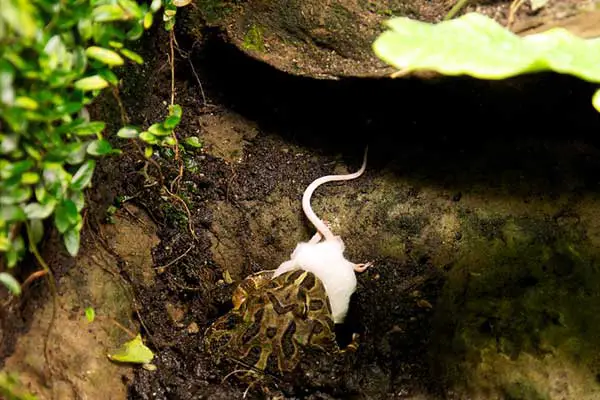
Recommendations
Crickets– live crickets are great, and provide some adding stimulation for your frog as they hunt them down. But you may not always have easy access to live crickets, so it’s good to have these freeze-dried crickets on hand.
Calcium supplement- your frog won’t likely get all the calcium it needs just from the crickets. Supplements like this one can be dusted onto their food before they eat to make sure they get enough.
4. Substrate
Substrate is the ground your frog will live on. They’ll spend pretty much their entire lives on it and in it, so it’s important to make sure you’ve got the right substrate in your terrarium. Substrate comes in many forms and different substrates work best for different species.
While some animals do best with mulch, gravel, or even plain reptile mats, none of these will work for pacman frogs. These frogs have two main requirements when it comes to substrate: 1. It needs to be able to hold onto moisture without rotting or growing mold and 2. The frog needs to be able to burrow into it.
The best type of substrate by far for pacman frogs is coconut fiber substrate. It’s soft and gentle on their skin, it can absorb and hold moisture without rotting, and it actually helps break down unpleasant odors and keep the terrarium fresh. It’s easy to burrow into as long as you make it deep enough.
Recommendations
Coconut Fiber Substrate– You can’t go wrong with this coconut fiber. It’s a trusted brand that’s been making this high-quality substrate for a long time. Your frog will thank you. Make sure to spread it at least an inch and a half deep. You can go deeper than that if you have an especially large frog. That gives them plenty of space to burrow into the substrate.
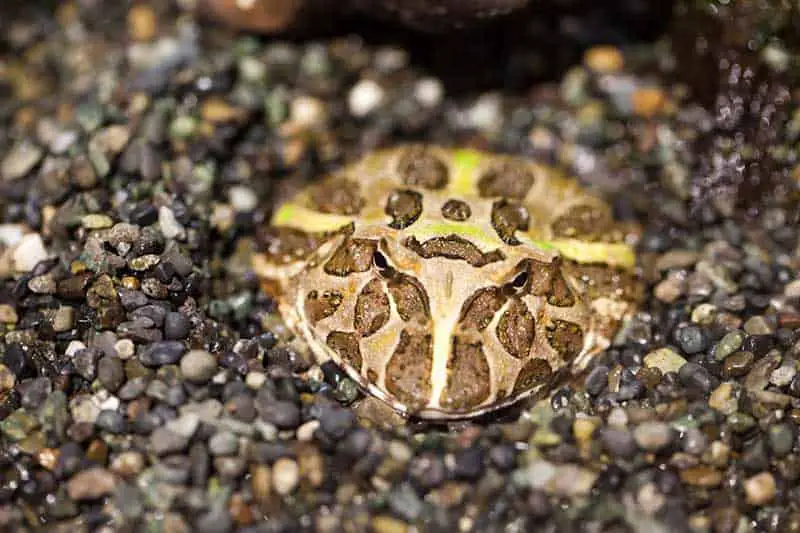
5. Maintenance
If there’s one thing that new frog owners often neglect, it’s maintenance. Your pacman frog, like any other living thing, will urinate and defecate, and create other forms of waste inside it’s terrarium. Since it lives in a closed environment, it’s effectively trapped in it’s home with it’s own waste.
That means you need to clean the terrarium with regularity. About once a week, you should remove your frog and place it in a secure container. Then remove all the rocks, hides, and vegetation and the water dish. Dig out all of the substrate and throw it out.
Then clean the inside of the terrarium. Wipe it down with warm water (no soap or disinfectant), and then wipe down all the furnishings- rock hides, the water dish, etc- and scrub them with a wet sponge if needed. Add fresh substrate back into the tank and replace all the furnishings and plants, and return your frog to its home.
Recommendations
Sponges– Frogs have sensitive skin, which means using soap or disinfectant is usually a bad idea. These sponges are specially designed to scrub your terrarium and furnishings clean without needing soap.
6. Handling
It’s going to be tempting to handle your frog a lot- but don’t do it. There are a couple of reasons to avoid handling your frog. First, frogs have delicate, porous skin. They breathe and absorb water through their skin, and any substance on your hands when you touch them will also be absorbed.
That means soap, your natural skin oils, and anything else you may have touched can be absorbed directly into the frogs bloodstream. So, for the health and safety of your frog, handle them only when necessary.
The second reason is that pacman frogs aren’t exactly docile. They’ll bite you, and they do have teeth. It can hurt, and the bite could easily get infected. It’s not terribly dangerous, but it’s definitely unpleasant.
Recommendations
Gloves– Sometimes it’s just necessary to handle your frog. Gloves like these are great for making sure you don’t expose your frog to any toxins from your hands when you remove them from the terrarium to clean it.
7. Other things to know
If for some reason the terrarium and substrate are allowed to dry too much, your frog will grow a tough outer layer of skin and enter a period of brumation (the reptile/amphibian version of hibernation). It won’t eat, won’t move, and won’t even react to the presence of food. People often mistake this for a dead frog, but your frog is very much alive. To understand how to take care of a pacman frog in this situation, once it’s rehydrated, it will shed and eat that tough outer layer of skin and behave as normal.
Pacman frogs as pets
Pacman frogs are delightful pets. They’re beautiful and unique in appearance, and they’re low-maintenance animals. While they’re beloved by people of all experience levels, they’re especially well suited to beginners.
Because they’ll eat nearly anything, don’t require a lot of specialized equipment or space, and rarely live longer than 7 years, they’re a perfect exotic pet to start with.
